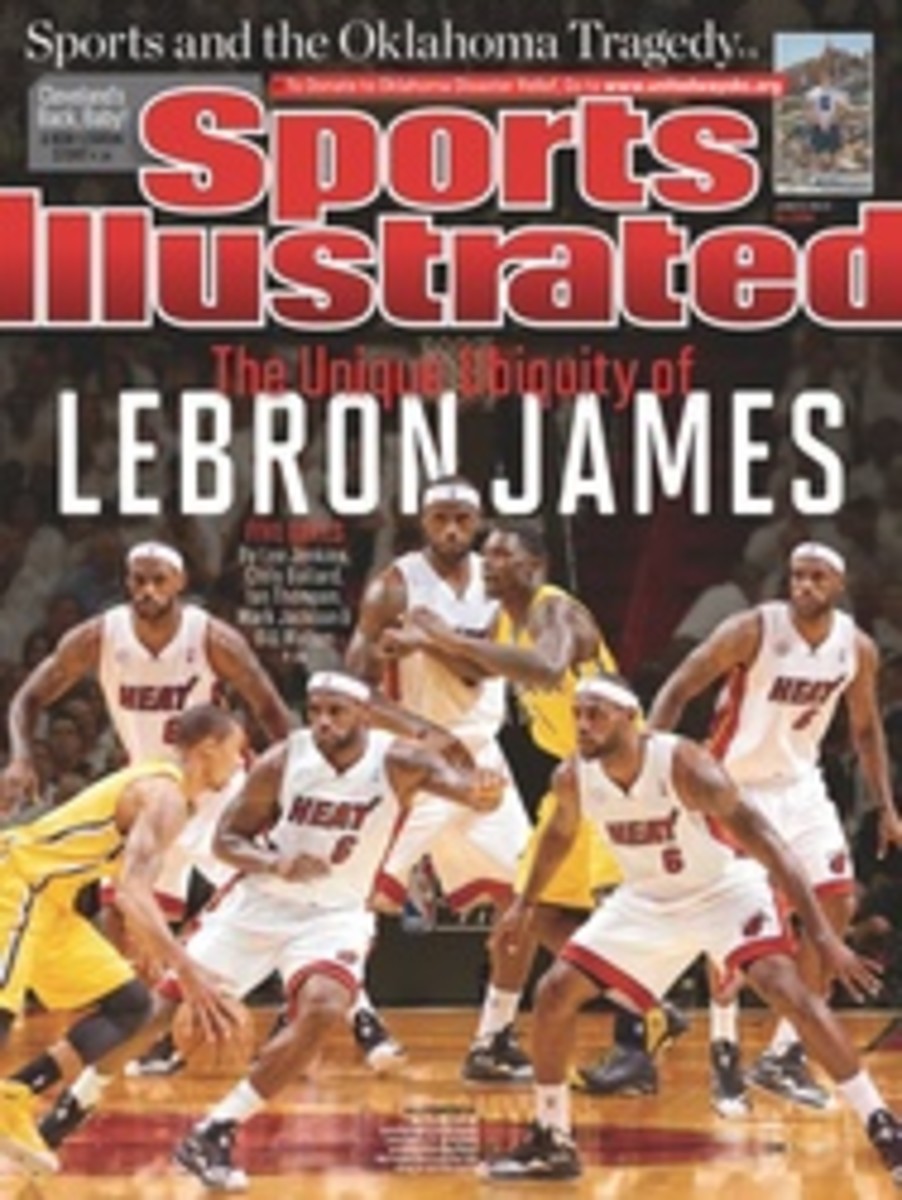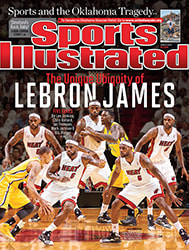
The Case for ... The Deutsch Approach
In 1976—perhaps the last time that German Fu√üball was indisputably cool—a program called Soccer Made in Germany debuted on PBS in America. Hosted by a Brit named Toby Charles and featuring a sound track of jaunty guitar music, the hourlong show gave soccer-starved Statesiders highlights from West Germany, where balls still bore old-school black pentagons and Franz (Der Kaiser) Beckenbauer still ruled the land. A generation of U.S. soccer nuts learned the game from those broadcasts, and it was a good place to do so: Deutschland was home to the reigning World Cup winner as well as the three-time defending European club champion, Bayern Munich.
It may have taken more than three decades, but German soccer is finally cool again. FUßBALL'S COMING HOME read one billboard last Saturday outside London's Wembley Stadium, where Bayern beat Borussia Dortmund 2--1 in the Champions League final, the first to be contested by two German teams. The world's marquee annual club game was played at a dizzyingly high level, complete with clever back-heels, sprawling saves, a remarkable goal line clearance and, in the end, a game-winner by Bayern's Arjen Robben. It was a deserved championship for a team that has enjoyed one of the greatest club seasons in European history, winning the German Bundesliga by 25 points and dominating storied Barcelona 7--0 over two games (7-0!) on its way to the Champions League crown.
All told, Bayern and Dortmund account for no fewer than 10 players on the German national squad that will be one of the favorites to win next year's World Cup in Brazil. In fact, so deep and talented is the German team these days that even the B-squad that faces the U.S. in a Washington, D.C., friendly on Sunday—minus most players from Bayern and Dortmund—is loaded with established stars and emerging prospects. Nearly all of them were produced in the thriving talent incubator that is the Bundesliga.
England may have the world's richest domestic league—the one NBC is paying $250 million over three years to broadcast in the U.S., beginning in August—and Spain may have the highest concentration of star power at its two superclubs, Real Madrid and Barcelona (sidebar, page 28). But Germany is positioned better than any European country for the long-term success of both its pro league and national team. Let us count the ways that German soccer rules these days:
The fan experience. The Bundesliga was the best-attended soccer league in the world this season, with average crowds of more than 42,000 for its 18 teams. Not only are its stadiums safe, family-friendly and largely new—thanks to the building boom that preceded the 2006 World Cup—but the cost of attending a match is also astonishingly low. Prices for season tickets to Bayern range from $160 to $820, far less than the $1,500 to $3,000 charged by Arsenal in England. One reason German fans have it so good is the league's 50+1 rule, established in 2001, which requires that a club's ordinary members—Bayern has 130,000, who pay between $40 and $75 annually—own the majority of any team. As a result, even the high-powered likes of Bayern and Dortmund aren't controlled by the types of international tycoons who have taken over in the English Premier League, often saddling their teams with debt and high ticket prices.
Financial stability. European soccer is the Wild West of the sports world, with no U.S.-style salary caps to level the playing field. If a Russian oligarch (see Chelsea's Roman Abramovich) or a Middle Eastern oil baron (Manchester City's Sheikh Mansour) wants to turn a Premier League team into his personal vanity project, losing hundreds of millions of dollars and driving up the price for players, he's free to do so. But such practices won't be the case once UEFA's Financial Fair Play rules go into full effect next season, preventing teams from spending more than they take in. Thanks to their lucrative sponsorships, revenue-generating stadiums and long-term financial health, German clubs (especially Bayern) are ideally situated for the start of FFP and should take advantage in European competition.
Player development. A look at Germany's national A-squad reveals—beyond stalwarts like Bayern's Philipp Lahm and Bastian Schweinsteiger—some of the most exciting young talent in the world: midfielders Mario G√∂tze (20 years old), Mesut √ñzil (24), Thomas M√ºller (23), Marco Reus (23), Ilkay G√ºndogan (22), Toni Kroos (23), Julian Draxler (19) and André Sch√ºrrle (22); and defenders Mats Hummels (24) and Jér√¥me Boateng (24). How did this happen? After Euro 2000, in which Germany scored just one goal, didn't win a game and finished last in its group, the national federation (DFB) teamed up with Bundesliga clubs to overhaul the country's youth development system, which had fallen into disrepair. DFB started a talent development program in '03 for children ages eight to 14, and teams across Germany's two club divisions were set up with academies staffed with hundreds of coaches to scout and produce technically skilled players.
These days, Bundesliga clubs are sinking $130 million a year into those academies, which receive regular quality-control inspections. And unlike in England, where wealthy teams buy up superstars and leave little room for homegrown youth, German clubs can more easily introduce young players into top-flight games. One youngster to watch in the U.S.-Germany game this week is Draxler, who joined his current club, Schalke, at age seven and who debuted in the Bundesliga at 17. Having just four coaches throughout his youth career "without major breakups or disruptions," he says, helped him assimilate. Now "[our teams] can throw us [young players] in at the deep end because we'll deliver."
With Germany's rise, however, there are caveats. For starters, there's Bayern's utter domination of the Bundesliga this season—note the 98--18 goal differential. Lack of parity is a concern all over Europe, but Bayern, the sole superclub in Germany, is living up to its singular reputation for poaching the best players from its rivals. It just purchased one of Dortmund's stars (G√∂tze) and appears headed toward another (striker Robert Lewandowski).
Another concern is the Bundesliga's international TV distribution. While U.S. viewers can now see 60 to 70 live soccer games each week from around the world, the league is stuck through the end of 2014--15 on GolTV, a small Miami-based channel that has been dropped recently by several U.S. carriers. If league officials are clever enough, they'll leverage German soccer's rising performance and popularity into better TV deals.
That said, it's still possible to see the best German teams easily on U.S. TV, in the Champions League on Fox Sports. (And don't forget that the U.S. roster for that friendly against Germany contains four German-Americans who decided to play for the Stars and Stripes: Fabian Johnson, Jermaine Jones, Danny Williams and Terrence Boyd.) What's more, worries over Bayern's Bundesliga preeminence may be exaggerated, considering that Dortmund won the league in the two seasons before this one and nearly raised the Champions League trophy despite having a player payroll less than one third the size of Bayern's. That's a testament to Dortmund's ability to develop its own players, buy smartly and entrust the operation to a charismatic and talented coach, Jürgen Klopp. It should ensure that former Barcelona manager Pep Guardiola doesn't have a free ride when he takes over at Bayern this summer.
Whatever ends up happening, the story lines in Germany will be worth watching, to say nothing of the soccer itself. It's enough to make you hope that someone soon revives Soccer Made in Germany for a 21st-century audience.
Follow @GrantWahl
It may have taken more than three decades, but German Fußball is cool again.
For Barça, a Brazilian Injection
By the stratospheric standards of FC Barcelona, this was a disappointing season: The Catalan powerhouse won only one trophy, the Spanish league title, and was demolished by Bayern in the Champions League semis. But Bar√ßa went a long way toward making amends last week (for itself and for La Liga, whose other power, Real Madrid, was upset by Dortmund) by landing the biggest transfer prize in world soccer: Neymar (left), the 21-year-old Brazilian forward who ended a two-year-long saga by announcing—on Instagram, no less—Barcelona as his destination in a $33 million deal, after spending the last five years at Santos.
Yet for all of Neymar's potential—he won the 2011 South American player of the year award and led Pelé's old club to the continental title—there remain doubts that he will dominate Europe like his new teammate, five-time world player of the year Lionel Messi. Neymar has yet to win anything important with the Brazilian national team, falling short at the '11 Copa América and the '12 Olympics, and it remains to be seen how his flashy game will translate to the physical Champions League. But there can be no debating: He's chosen a club that will give him the conditions to succeed at the highest level.
PHOTO
ANDREAS GEBERT/EPA
BASTIAN SCHWEINSTEIGER
PHOTO
GERRY PENNY/EPA (ROBBEN)
BASKING IN ROBBEN The Bayern winger assisted here on his team's opening goal last Saturday, then beat Roman Weidenfeller in the 89th minute to win it all.
PHOTO
SEBASTIÃO MOREIRA/EPA (NEYMAR)

